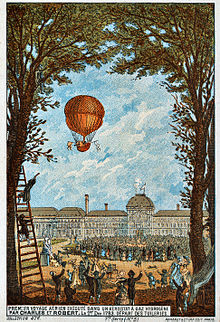Who created the first airborne hydrogen balloon?
 August 27, 1783 — Today, the hydrogen balloon took off from the Champ-de-Mars in Paris. Benjamin Franklin and other dignitaries attended the event, which today is the site of the Eiffel Tower.
August 27, 1783 — Today, the hydrogen balloon took off from the Champ-de-Mars in Paris. Benjamin Franklin and other dignitaries attended the event, which today is the site of the Eiffel Tower.
It was airborne for 45 minutes and traveled a total of 21 kilometers into the village of Gonesse. According to reports, local peasants in Gonesse were so frightened by the balloon that they attacked it with pitchforks and punctured it.
Designed by brothers Anne-Jean and Nicolas-Louis Robert, these French engineers worked under Jacques Charles at the Place des Victoires in Paris. The brothers designed the hydrogen balloon based on Charles’s work.
The brothers improved on their creation, and by December 1783 built the first manned hydrogen balloon, which they piloted.
Sources: wikipedia, civilwar
Sources
Words of Wisdom
Some guns were fired to give notice that the departure of the balloon was near. ... Means were used, I am told, to prevent the great balloon's rising so high as might endanger its bursting. Several bags of sand were taken on board before the cord that held it down was cut, and the whole weight being then too much to be lifted, such a quantity was discharged as would permit its rising slowly. Thus it would sooner arrive at that region where it would be in equilibrio with the surrounding air, and by discharging more sand afterwards, it might go higher if desired. Between one and two o'clock, all eyes were gratified with seeing it rise majestically from above the trees, and ascend gradually above the buildings, a most beautiful spectacle. When it was about two hundred feet high, the brave adventurers held out and waved a little white pennant, on both sides of their car, to salute the spectators, who returned loud claps of applause. The wind was very little, so that the object though moving to the northward, continued long in view; and it was a great while before the admiring people began to disperse. The persons embarked were Mr. Charles, professor of experimental philosophy, and a zealous promoter of that science; and one of the Messrs Robert, the very ingenious constructors of the machine.
{While U.S. ambassador to France, writing about witnessing, from his carriage outside the garden of Tuileries, Paris, the first manned balloon ascent using hydrogen gas by Jacques Charles on the afternoon of 1 Dec 1783. A few days earlier, he had watched the first manned ascent in Montgolfier's hot-air balloon, on 21 Nov 1783.}




